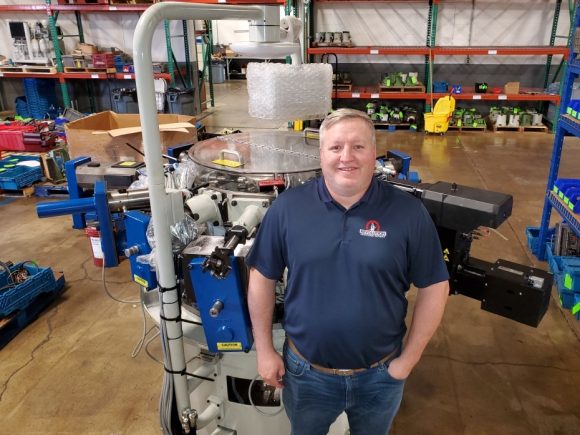My guest on today’s show is Kris Fugate, President of Revolution Machine Works, a prominent rotary transfer machine rebuilder, specializing in Hydromats. Hydromats can seem strange and overwhelming to those unfamiliar with them. Some say they their circular shape with 12 or 16 work stations reminds them of a UFO, and the machines can crank out complex turned parts like nothing else out there.
*************
Listen on your favorite podcast app using pod.link.
View the podcast at the bottom of this post or on our YouTube Channel.
Facebook: https://www.facebook.com/swarfcast
Instagram: https://www.instagram.com/swarfcast/
LinkedIn: https://www.linkedin.com/company/todays-machining-world
Twitter: https://twitter.com/tmwswarfblog
*************
Link to Graff-Pinkert’s Acquisitions and Sales promotion!
*************
Interview Highlights
How Rotary Transfers Work
Kris started the interview explaining how rotary transfer machines, particularly Hydromats, function and why they are such unique productive machines. How is it possible that parts which require several multi-spindle screw machines, or have cycle times of 2 minutes on a CNC lathe, can run complete on a Hydromat in 20 seconds?
Most Hydromats are configured in a rotary dial-like shape. Unlike on a screw machine, in which the bar of material rotates and the tools are stationary, on a Hydromat the bar remains stationary and the tools rotate. Each station (unit) of the transfer machine functions like a CNC lathe or CNC mill. Units can do work such as turning, threading, milling etc. Each station machines one operation and then transfers the part to the next station for the next operation.
Advantages of Hydromats over other Turning Machines
Hydromats have individual feeds and speeds in each station, so they aren’t held captive to the slowest operation, such as on an Acme-Gridley or other traditional multi-spindle screw machine.
They usually come equipped with an inverting unit, which removes a part from a collet, rotates it and places it back in the collet so it can be machined from the other side. This feature makes Hydromats ideal for machining double sided fittings.
Unlike a lot of other rotary transfer machines, which are set up with the stations vertically arranged in the trunnion style that resembles a Ferris wheel, most Hydromats are set up horizontally, more like a carousel. This enables modular units that can be easily swapped, making easy, quick changeovers.
Also, Hydromats are designed with a hirth ring coupling, which enables them to maintain tight tolerances part after part.
Revolution Machine Works
Kris’s company, Revolution Machine Works, services and sells refurbished and rebuilt turnkey Hydromats, and also supplies Hydromat spare parts. They often do entire overhauls on the machines, stripping them down to the casting. They rebuild units, and equip the machines with new Fanuc controls. While the Hydromats that Revolution provides are the non-CNC hydraulic generation, the company sometimes equips the machines with individual CNC units made by the Italian rotary transfer machine company DM2. Revolution Machine Works also distributes new DM2 machines in the U.S.
Hydromats are Tough Business
Since I went into the used machinery business over a decade ago, I’ve spent a lot of time learning about Hydromat rotary transfer machines. I’ve traveled to Germany, Italy, Switzerland and Norway to find them because you can make a nice buck if you find the right customer. Still, it’s always seemed like we had to have 10 interested customers to sell one Hydromat. It can get frustrating watching the machines sit in the Graff-Pinkert warehouse for years.
Why do customers hesitate to buy these machines that can crank out great parts by the millions. Perhaps its because they often cost a few hundred thousand dollars, and then a bunch more money to set up. Kris could relate to my experience. A rebuilt, turnkey Hydromat, has double or triple the price tag of one that Graff-Pinkert would sell, and the customers expect considerable service.
In the interview, Kris pointed out a lot of the other challenges Hydromat customers face. The machines take up a lot of floor space—perhaps large enough to fit three CNC machines. They require at least one expert to keep them running correctly, and it can take six months to a year to train a Hydromat operator.
Kris says he and colleagues often joke that they picked the hardest way to make money.
We both agreed that it’s much easier to sell a Hydromat to someone who already has them. They have units on the shelf, expertise, comfort, and enough work for the machines.
Yet Kris says his work is most rewarding when he is able to get a new client into the Hydromat business. A Hydromat can be a game changer for a company in the high volume parts business, yet a purchase comes with significant risk. Years ago, he ran Hydromats in his family’s machining company D & S Machine Pts. He says he can still remember how it felt when the company paid over a million dollars to buy its first new Hydromat, its biggest capital investment at the time. I can tell that being able to put himself in the shoes of his customers is helpful for Kris to sell machines, but more importantly, it’s clear that it gives him a sense of purpose.
Question: Do you prefer to buy, used, rebuilt, or brand new machine tools?
Podcast: Play in new window | Download



